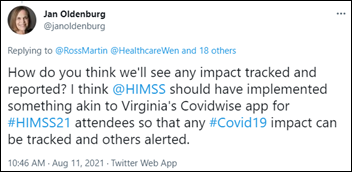EPtalk by Dr. Jayne 9/23/21
Hospitals in my city are in lockstep as far as requiring COVID-19 vaccinations for employees, with compliance upwards of 98% for most facilities. Employees who aren’t compliant and don’t qualify for a religious exemption are finding that there isn’t anywhere to work unless they want to relocate or leave healthcare, so difficult choices are being made. In that context, I was interested to read about the approach being taken by Conway Regional Health System in Arkansas.
The system asks that those employees claiming a religious exemption attest that they understand that the same fetal cell lines they object to being used during development of the vaccine were also used in the development of commonly accepted medications such as Benadryl, Sudafed, and Tylenol. They go further in asking employees to confirm that their “sincerely held religious belief” prevents them from taking those medications as well. Many of my physician colleagues and I have had ongoing conversations about the fact that so many of the world’s major (and often fractious) religious groups have found common ground on recognizing COVID-19 vaccines as permissible and often encouraged. If only they could find common ground on other topics as well. Kudos to the system’s leadership for making sure its employees understand the science behind their exemption requests and what it might mean for non-vaccine products.
I left my most recent in-person clinical employer for a variety of reasons, including such factors as inadequate personal protective equipment, hellacious hours, short staffing, and cultural issues. Regarding the latter, we had reached a point where the mentality of “the customer is always right” had come to interfere with patient care by creating an environment where physician judgment was being questioned, and where leadership was turning a blind eye to clinicians who were prescribing non-evidence-based therapies like hydroxychloroquine and ivermectin for COVID prevention. A recent MSN article brought back some negative memories. The headline “Entitled consumers have terrorized service and retail workers throughout the pandemic” also applies to healthcare.
In checking with my former colleagues, patients are still throwing fits that they can’t be accommodated quickly for pre-travel testing due to the extremely high demand for testing. Patients register at 6 a.m. and often aren’t able to be seen until 2 or 3 p.m., so they take their anger out on the staff when they arrive. Never mind the fact that my county has free drive-through testing at the county health department, where test turn-around time is about 4 hours – patients don’t want to drive to what they perceive as “the wrong side of the tracks” for testing for a variety of preconceived notions. When you do the math, it would be more efficient even with the crosstown drive, and it’s certainly cheaper since my former employer is requiring a full physician visit (and urgent care co-pay) even for testing. However, the perception of convenience or quality or service is everything, apparently.
The practice is still fighting the most basic of battles, including patients who refuse to wear their masks properly despite being in a healthcare facility where known COVID-19 positive patients are present, and clinicians aren’t permitted to refuse to see patients who refuse to mask up. Patients who haven’t planned adequate turnaround time for their pre-travel PCR testing are permitted to complain to leadership, who will allow them to take their specimen swabs and personally drive them to the lab vendor for expedited service. This adds extra steps for the already overburdened staff. The organization still has approximately 20% of its locations closed due to lack of staffing and has even started its own emergency medical technician training program in an effort to bolster reserves. However, they seem unwilling to look at evolving the practice culture as a way of improving staff retention and satisfaction.
Unfortunately, many healthcare organizations will continue to confront these types of scenarios (and others which may be even more challenging) as the pandemic continues to rage. Healthcare has changed so much in the last 18 months; I can’t even imagine what it might look like if we ever make it out the other side of this. The reality is that we are one vaccine-resistant variant away from going back to square zero, and it feels like clinical teams are constantly waiting for the other shoe to drop.

The IT arm of Ascension plans to outsource an additional 330 technology jobs in the next few months, according to a Missouri state filing. The organization had already planned to lay off over 600 workers during the bottom half of the year. It’s hard to understand the true economic impact of these cuts because Ascension had transitioned earlier this year to allowing all employees to work remotely, which makes it more challenging to understand where the impacted positions are based. Functions being outsourced include application support, end user engineering, network services, and telecom. I always enjoy looking at primary source materials and, in this case, nearly 30% of the text of the document was redacted, so I will have to use my imagination to conjure up what I might have missed.
Today ONC awarded more than $73 million in Public Health Informatics & Technology Workforce Development Program funding to 10 college and university consortia. The funding comes from the American Rescue Plan and is targeted to providing training in public health informatics and technology for over 4,000 individuals. Organizations receiving funds include Historically Black Colleges and Universities, Hispanic Serving Institutions, Asian American and Native American Pacific Islander-Serving Institutions, and other higher education organizations. I’m pleased to see the diversity of recipients as we move forward addressing social determinants of health, as there are many underrepresented demographics in the public health workforce.
The funds will help provide support for curriculum development, recruiting, training, paid internships, and career placement assistance for those seeking positions in public health organizations. Having come up through the informatics ranks in a large hospital system, I didn’t have a lot of exposure to public health informatics. As I studied for my clinical informatics board certification, I found it to be one of the more interesting domains of the subspecialty. I’m excited to see it receiving more focus and hope that the funding helps attract some of the best and brightest to the discipline.
News of the weird: The State Medical Board of Ohio has given a two-year renewal to a physician who claims that vaccines cause people to become magnetic. The board has the opportunity to discipline a physician for false statements by a vote of at least half its members, yet it has failed to act in this case. The article goes on to mention that another notorious physician, this one of ivermectin fame, has his license coming due October 1. He has openly admitted to clinical wrongdoing, and it will be a travesty if the board continues to allow him to practice.
One of the reasons that state licensing boards are fighting against national licensure is their claimed need to police their own physicians. I’d recommend that if they’re going to continue to make that claim, that perhaps they start stepping up surveillance of those spreading dangerous misinformation.
Do you think state medical boards are living up to their responsibilities for physician discipline? Leave a comment or email me.

Email Dr. Jayne.


















The ruling does seem to actually touch on things like UserWeb access "...the final rule applies to terms and conditions…